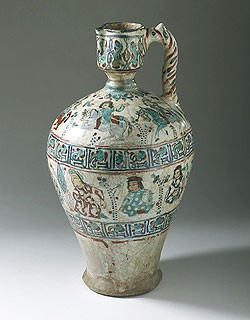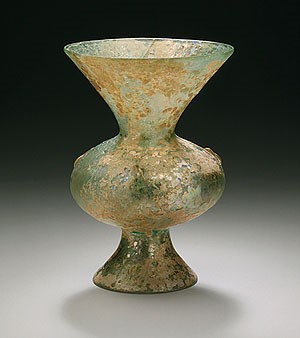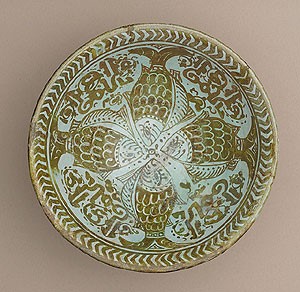Islamic art includes artistic traditions of countries that developed under Islamic rule or influence, these are the countries that are extending from Southern Spain to Central Asia. The works of art created in these countries are very different and similar at the same time. They are united by one style and the same purpose, but they are also characterized by strong local influence and influence form other nearby countries. Islamic art is represented by numerous works which have cultural, decorative and functional meaning.
In the following paper I will examine the example of the mina’i ware Ewer (Fig. 1) in order show how these aspects are presented in the ewer of the 12th century which is a perfect example of new tendencies and techniques in design of Islamic ceramics of the medieval period.

- Iran, late 12th to early 13th century
- Fritware, overglaze painted (mina’i)
- Height: 13 in. (33.0 cm)
The work of Fahmida Suleman states that Islamic ceramics “represent a very small percentage of the total ceramic assemblage produced in the medieval Muslim world.” It was used for domestic purposes and comprised unglazed storage and transport jars and “unglazed bowls, platters, and receptacles, which were made for the kitchen, pharmacy, or market shop.”
However, with the introduction of new techniques of design, ceramics began serving for decorative purposes and was considered a sough commodity in courtly context. We see this in the actual ewer by considering the form of the object and decorative details, such as delicate paintings which were produced to symbolize a “good life” of the owner.
The techniques of painting are typical for the 12th century and show the new stage of development in the Islamic art which later became very popular all over the world. The analysis has shown that a chosen ever helps establish the way of development of the mina’i artistic style and follow its travel between other cultures, such as Chinese.
The ewer presents a new type of luxury ceramics which was characteristics for Iran and neighboring countries in the second half of the 12th century. It is an example of the luster painting technique. It was a very costly process and the ceramic vessels made in such way were very expensive.
Consequently, only higher layers of society could afford to buy them. The process was quite difficult. A jar, or any other vessel was covered with glaze (white or a turquoise opaque) and fried. “The decoration was applied both under and over the glaze. Stable colors such as cobalt blue and turquoise, which could be fired successfully at a high temperature, were applied under the glaze before the first firing. The less stable colors — including red, black, and gold — were applied to the cold glazed surface and fixed in a second firing at a lower temperature.”
The ceramics of the period is very significant in religious and cultural context and related to the historical events. The ewer is decorated with figures taken from the Persian literature subjects, “The paintings on mina’i ceramics attest to the existence of a vibrant tradition of Persian illustrated manuscripts from this period, which is now lost. Indeed, both mina’i and Persian lustre portray visual and poetic themes derived from Persian literature, such as the Shahnama epic or the romance of Varqa va Gulshah, depicting warriors, heroes, lovers, and fantastical beasts.”
The subjects of paintings were created to demonstrate happy and good life. The actual ewer depicts the figures of horseman in the upper register, musicians and dancers in the lower register. Such themes were distinguished characteristics of the time period when Islamic world began its fast cultural and economic development.
The Islamic invasion of the world also began in this period. From the context of the paintings, we can judge about values that shared people of the period. For example, the horsemen and situated in the upper register of the ewer symbolizes that people valued this art of ride and it was very important for military purposes. Furthermore, singers and dancers in the lower register show that nation was culturally developed and the art of dancing and singing was appreciated in the Islamic world.
People in the paintings wore rich closes which symbolizes that nation was on its economic rise. The objects of the ewer are particular Islamic. They share typical Islamic painting techniques and characteristic color scheme (red, purple, blue, gold). In addition, the paintings demonstrate traditional clothes which can also serve a source of historical and cultural information about the period.
As it has already been motioned, such ceramics was very expensive and only rich people could have it. The ewer probably served for decorative purposes and was used only on special occasions in order to demonstrate prosperity and good taste of the patron to his guests. The ewer was a luxury, and was used for decoration of the house. Design, decorative motifs, function, patronage of the ewer tells about cultural and artistic influence of other counties.
The exiting decorative scheme was first introduced in Syria and later it came to Iran and China, “As with Persian lustre, Kashan appears to have been the main centre of production for mina’i, with vessel shapes ranging from bowls, pilgrims’ flasks, ewers, cups, and, in rare instances, tiles.”
The painting does not really demonstrate Islamic ideology because the purpose of the vessel was to show the material prosperity of its owner, but it speaks much of the culture of the country and demonstrates a “potentially unique expression of a desire or need.”
Moreover, this technique had a great influence on other countries though it was short-lived in Iran which can be explained with the technical problems associated with overgraze technique of painting which could lead to unsatisfactory result, thus, only true masters could create such articles.
In the 14th century, the technique was exported to China and later it was transferred to the Middle East where it caused “a fashion craze in the Muslim markets.” Having been replaced from its original use, the ewer still represents a uniqueness of the Islam culture. These days, we are lucky to observe it in a museum, but for contemporary people it has a quite different meaning.
These days, we consider it only as an example of the cultural heritage and a source of information about the 12th century period of the Islamic history. As opposed to a “contemporary perception” of this article, people of the medieval period paid much more attention to the meaning of it as luxury and symbol of prosperity and development.
The art of this period presents more secular than religious art, “It would not be an exaggeration to conclude in the medial art as a whole, which is so often seen as a centered on religion, Islamic architecture appears as a sort of conscious secular variant.”
Two other examples of the late 12th century art is an Eastern Mediterranean Lamp (Fig. 2) and a Bowl (Fig. 3) from Egypt. Regardless the fact that they are “representatives” of the same period and the same Islamic art, a strong local influence can be observed in technique and decorations they represent.

- Eastern Mediterranean, 12th to 13th century
- Glass, applied handles
- 5¼ x 3¾ in. (13.34 x 9.53 cm)
In a bowl, we can see typical motifs of the Egyptian luster painting of the early 11th century which was popular in the 12th century as well.

- Egypt, 12th century
- Earthenware, overglaze luster painted
- 2 9/16 x 6 13/16 in (6.51 x 17.3 cm)
The typical decoration presents the figures of people and animals (4 golden fish which were symbols of the prosperity in the Arab world) and typical golden color. The lamp was produced during the Ayybid rule and made of the Ayybid glass. The design of the lamp seems to be not characteristic for the Islam art, especially comparing with the previously discussed ewer.
Thus, we can conclude that Islamic art was very divers. Even within one time period, the design and ornaments of articles were very different from each other. The reason of this diversity lies in the diversity of cultures that were united under the Islamic rule in the 12th century.
Thus, Islamic ceramics of the 12th century is one of the greatest sources of information about Islamic culture and traditions. It is characterized by rich painting and great subjects which were used to show the prosperity, cultural and economic growth with is associated with the Islamic world of the medieval period.
In addition, Islamic art of this period had a great influence of art of other countries and made a great contribution to development of new design techniques. Having been placed in contemporary setting, it did not lose its greatness and value, though, the perception of it is different with contemporary people.
Bibliography
Grabar, Oleg. Islamic Art and Beyond. Burlington: Ashgate Publishing, Ltd., 2006.
Komaroff, Linda. “Islamic Art: Early Medieval Period,” Los Angeles County Museum of Art, n. d. Web.
Suleman, Fahmida. “Ceramics,” in Medieval Islamic Civilization. Ed. Josef W. Meri, and Jere L. Bacharach, 143 – 144. New York: Routledge, 2006.